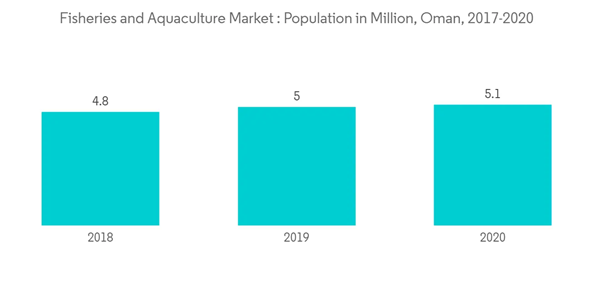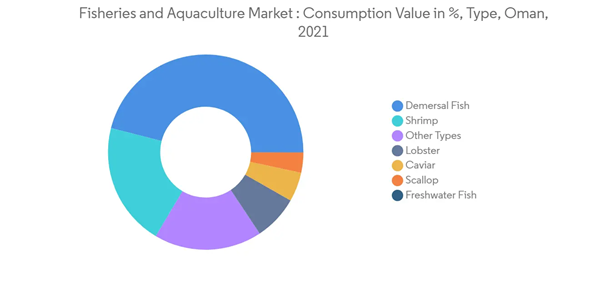The Oman Fisheries and Aquaculture Market size is estimated at USD 636.78 million in 2024, and is expected to reach USD 860.22 million by 2029, growing at a CAGR of 6.20% during the forecast period (2024-2029).
In addition to the severe implications on people's health and the healthcare services, the COVID-19 outbreak had a significant impact on sales of various businesses, including fisheries and aquaculture, in 2020. After the first case of COVID-19 was reported in Oman, the government responded quickly to enforce various preventive measures such as social distancing and closing of public places. These measures significantly impacted the fisheries and aquaculture sector in Oman due to disruption in both the market forces of demand and supply. The travel restrictions and social distancing measures had a massive impact on brick-and-mortar retail. As the demand from the hospitality, restaurant, and catering sectors represented a significant share of fish consumption, a negative impact was observed from the demand side.
Oman is one of the largest fish producers in the GCC region and a net exporter of fish and fish products. The fisheries and aquaculture sector is the most important and oldest sector in Oman. The Oman Aquaculture Development Company (OADC), under its National Food Security Program, planned to double production from about 200,000 metric tons in 2016 to 480,000 metric tons in 2020. The Ministry for Agriculture and Fisheries is focusing on increasing aquaculture production to 2,20,000 metric tons, with a value of USD 883 million by 2030. Oman's environmental advantage provides a high potential for the development of aquaculture, and there is a strong commitment from the government to develop this sector in a competitive and sustainable manner in harmony with the social, economic, cultural, and historical values of the country.
This product will be delivered within 2 business days.
In addition to the severe implications on people's health and the healthcare services, the COVID-19 outbreak had a significant impact on sales of various businesses, including fisheries and aquaculture, in 2020. After the first case of COVID-19 was reported in Oman, the government responded quickly to enforce various preventive measures such as social distancing and closing of public places. These measures significantly impacted the fisheries and aquaculture sector in Oman due to disruption in both the market forces of demand and supply. The travel restrictions and social distancing measures had a massive impact on brick-and-mortar retail. As the demand from the hospitality, restaurant, and catering sectors represented a significant share of fish consumption, a negative impact was observed from the demand side.
Oman is one of the largest fish producers in the GCC region and a net exporter of fish and fish products. The fisheries and aquaculture sector is the most important and oldest sector in Oman. The Oman Aquaculture Development Company (OADC), under its National Food Security Program, planned to double production from about 200,000 metric tons in 2016 to 480,000 metric tons in 2020. The Ministry for Agriculture and Fisheries is focusing on increasing aquaculture production to 2,20,000 metric tons, with a value of USD 883 million by 2030. Oman's environmental advantage provides a high potential for the development of aquaculture, and there is a strong commitment from the government to develop this sector in a competitive and sustainable manner in harmony with the social, economic, cultural, and historical values of the country.
Oman Aquaculture Market Trends
Increase in Seafood Demand
Oman's growing population, thriving economy, and profile as one of the popular tourist destinations have increased the demand for quality food products. The population of the country has also risen gradually. According to the World Bank, the population in the country was 4.5 million in 2016. This rose to 5.1 million by 2020, placing a critical need on the sustainable and efficient management of marine resources and fish stock. The population growth rate and the consumption rate are expected to be the major factors driving the fisheries and aquaculture sector in the country. However, the marginal rise in disposable incomes and prosperity, accompanied by a noticeable shift in the dietary preferences of consumers in the country, as they have expanded their diets to include more meat of fish and seafood, may consequently contribute to the growth of the market. Oman has resource biodiversity along more than 3,000 km of coastline. It has the strategic advantage of being close to the major export regions that are politically stable and have orderly civil societies. Thus, these factors boost the market in the country.Demersal Fish Segment Dominates the Market
Demersal fishes are the most popular and dominate the market in the country. Demersal fishes include grouper, trevally, emperor, and pomfret. The orange-spotted grouper is the most popular fish species in the country, but it has been pushed to the brink of extinction, which makes its procurement through aquaculture even more important. The major fish market in Oman is Muttrah. Most production is consumed locally, although some fish is exported to neighboring countries. Malabar Trevally, Orange Spotted Trevally, Brownback Trevally, Golden Trevally Blacktip Trevally, and Coast Trevally are some of the major trevally varieties caught in the region. Golden Toothless Trevally, Yellow Stripe Trevally, and Black Banded Trevally are a few of the majorly produced varieties in Oman. In line with the rapid growth and development, the population of Oman has risen exponentially, thus creating a need for the sustainable and efficient use of resources available in the region. Therefore, the increase in local demand due to the increasing population is anticipated to boost the market over the coming years.Additional Benefits:
- The market estimate (ME) sheet in Excel format
- 3 months of analyst support
This product will be delivered within 2 business days.
Table of Contents
1 INTRODUCTION
4 MARKET DYNAMICS
5 MARKET SEGMENTATION
Methodology

LOADING...










